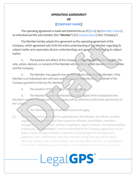What Are Considered Material Decisions in an LLC Operating Agreement?
Running an LLC involves countless decisions, but not all of them require approval from the entire membership. Material decisions are the high-impact...
7 min read
LegalGPS : Feb. 26, 2025
When an LLC owner decides to sell their interest in the company, it can create challenges for both majority and minority members. What happens if a majority owner wants to sell their stake but minority owners want to stay? Or what if minority owners fear being left behind with a new, unknown majority owner?
This is where tag-along and drag-along rights come into play. These provisions—commonly included in an LLC Operating Agreement—help balance the rights of majority and minority members when an ownership sale occurs.
Clearly defining these rights in an LLC Operating Agreement helps prevent disputes, ensure fair treatment of all members, and create a smoother exit process when ownership changes occur.


Legal GPS Pro
Protect your business with our complete legal subscription service, designed by top startup attorneys.
Tag-along rights (sometimes called "co-sale rights") ensure that if a majority owner sells their interest, minority owners have the option to join the sale under the same terms and conditions.
"An LLC has three members: Alex (70%), Jordan (15%), and Taylor (15%). Alex finds a buyer who wants to purchase their 70% stake. Under a tag-along provision, Jordan and Taylor can choose to sell their shares at the same price and terms as Alex, ensuring they are not left in a weakened position with a new controlling owner."
Drag-along rights force minority members to sell their shares if a majority of members agree to sell the business. These provisions ensure that buyers can acquire 100% of the LLC, rather than being stuck with holdout members who refuse to sell.
"An LLC has five members, with a majority group (owning 80%) receiving a lucrative acquisition offer. One member, who owns 10%, refuses to sell. Because of the drag-along clause, the holdout member is legally required to sell their stake at the agreed-upon terms, allowing the deal to proceed."

Attorney-Drafted LLC Operating Agreement
Get a customizable, attorney-drafted LLC Operating Agreement built for legal protection.
Trusted by 1,000+ businesses to safeguard their LLCs.
Tag-along and drag-along rights must be clearly defined in an LLC Operating Agreement to avoid ambiguity and disputes. Below are key elements to consider when drafting these provisions.
Not every transfer of ownership will trigger these rights. The Operating Agreement should specify:
"An LLC agreement states that drag-along rights apply only if members holding at least 75% of ownership approve the sale. When an acquisition offer comes in, the largest member holding 60% cannot force the minority members to sell unless they gain support from an additional 15% of the ownership group."
The Operating Agreement should specify how members approve sales and enforce these rights.
| Decision Type | Simple Majority (51%) | Supermajority (66%-75%) | Unanimous Consent (100%) |
|---|---|---|---|
| Triggering drag-along rights | ❌ | ✅ | ❌ |
| Exercising tag-along rights | ✅ | ❌ | ❌ |
| Amending tag-along/drag-along provisions | ❌ | ✅ | ❌ |
This structure ensures balance between the interests of majority and minority members while keeping decision-making clear.
Once triggered, tag-along and drag-along rights must include clear terms regarding:
"An LLC receives a buyout offer where the acquirer is paying 80% in cash and 20% in stock. Minority members exercising their tag-along rights must receive the exact same payment structure to ensure fairness."


Legal GPS Pro
Protect your business with our complete legal subscription service, designed by top startup attorneys.

Attorney-Drafted LLC Operating Agreement
Get a customizable, attorney-drafted LLC Operating Agreement built for legal protection.
Trusted by 1,000+ businesses to safeguard their LLCs.
When drafting an LLC Operating Agreement, it’s essential to use clear, enforceable language to define tag-along and drag-along rights. Below are sample provisions that can be customized based on your LLC’s specific needs.
This clause protects minority members by allowing them to join in on a sale when a majority owner sells their interest.
Sample Provision:
"If any Member or group of Members holding at least [X]% of the Membership Interests in the Company proposes to sell their Interests to a third party, then each remaining Member (the ‘Tag-Along Members’) shall have the right, but not the obligation, to sell their proportional share of Interests at the same price and under the same terms as the selling Members. The selling Members shall provide written notice to all Tag-Along Members at least [X] days before the proposed sale, specifying the material terms of the transaction. Each Tag-Along Member shall have [X] days from receipt of such notice to elect, in writing, to participate in the sale. Failure to respond within the notice period shall be deemed a waiver of such rights."
This clause ensures that if the majority agrees to sell the LLC, minority members must participate in the sale under the same terms.
Sample Provision:
"If Members holding at least [X]% of the Membership Interests in the Company (the ‘Approving Members’) approve the sale of the Company or substantially all of its assets, then all Members, including those who did not approve the sale, shall be required to sell their Interests on the same terms as the Approving Members. The Approving Members shall provide written notice to all Members specifying the terms of the transaction. Each Member agrees to execute any necessary documents to facilitate the sale and shall not take any action that would hinder or delay the transaction."
To make these provisions effective, consider including:
Even with well-drafted provisions, misunderstandings or legal disputes can arise. Here’s how to avoid common mistakes:
Ambiguous language can create uncertainty about when rights apply and how members must comply.
Solution: Clearly specify thresholds, notice periods, and exclusions in the Operating Agreement.
Drag-along provisions can be abused if a majority owner forces a sale at an unfair price.
Solution: Require a third-party valuation if any member disputes the sale price.
If minority members don’t receive adequate notice, they may challenge the sale.
Solution: Ensure tag-along and drag-along clauses include written notification procedures and clear deadlines for responses.
Tag-along and drag-along rights help balance majority and minority ownership interests in an LLC. By clearly defining these rights in an LLC Operating Agreement, members can ensure smoother transactions and prevent legal disputes.
If you’re structuring an LLC and want to include these protections, check out our customizable LLC Operating Agreement template to simplify the process.
The biggest question now is, "Do I need a lawyer for an Operating Agreement?” For most businesses and in most cases, you don't need a lawyer to start your business. Instead, many business owners rely on Legal GPS Pro to help with legal issues.
Legal GPS Pro is your All-In-One Legal Toolkit for Businesses. Developed by top startup attorneys, Pro gives you access to 100+ expertly crafted templates including operating agreements, NDAs, and service agreements, and an interactive platform. All designed to protect your company and set it up for lasting success.

Legal GPS Pro
Protect your business with our complete legal subscription service, designed by top startup attorneys.
| Premium Template Single-use Template |
Legal GPS Pro Unlimited Access, Best Value |
|
|
| Choose Template | Learn More |
| Trusted by 1000+ businesses | |
Table of Contents

Running an LLC involves countless decisions, but not all of them require approval from the entire membership. Material decisions are the high-impact...

At some point, LLC owners may need to transfer their ownership interest—whether by selling to a new member, passing it to an heir, or restructuring...

The death of an LLC member can create legal, financial, and operational challenges if the Operating Agreement doesn’t clearly outline what happens...